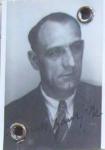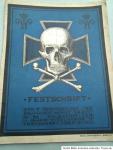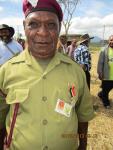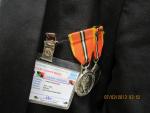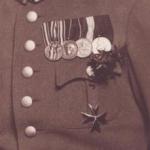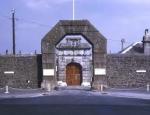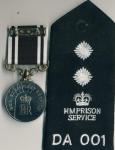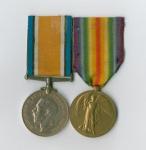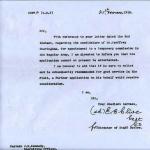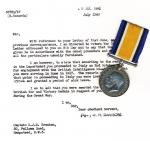-
Posts
2,470 -
Joined
-
Last visited
-
Days Won
2
Content Type
Profiles
Forums
Blogs
Gallery
Events
Store
Everything posted by dante
-

Wehrmacht Wehrmacht Prison Guard
dante replied to dante's topic in Germany: Third Reich: Research, Documentation & Photographs
Cheers H, yes I got it to compliment a Torgau prisoners wehrpass -
Johannes Robert Banaschik was born 1995 in Dresden. By May 13th 1915 he joined "1. Königlich Sächsisches Jäger-Bataillon Nr. 12" and fought on both, East and West Front. Later in WWI he fought with "Infanterie Ersatz Bataillon 102". In WWI he was awarded with EKI, EKII and Frontkreuz. With the beginning of WWII Baschanik - now 45 years old (!) - joined "Landesschützen-Bataillon 353" in December 1939 and in May 1940 he changed to "Landesschützen-Bataillon 364". Both were part of "Division z.b.V. 404" which didn't see any action at this time. In August 1940 (promoted to Unteroffizier) he became a prison guard at "Wehrmachtsgefängnis Torgau" where he stayed until March 1941. In March 1941 he left Torgau to "Wehrmachtsgefängnis Lager Marie über Bitterfeld" where he stayed until July 1942. Now with the rank of a Feldwebel he had a short stay from July 1942 until March 1943 in "Feldstraflager 1" in Northern Finland. From March 1943 until September 1943 he was a guard at "Wehrmachtsgefängnis Torgau Fort Zinna" again. Being promoted Oberfeldwebel he had a one-week-stay at "Wehrmachts Gefangenen Abteilung Milowitz" before getting back to Torgau Zinna for another week until September 20th 1943. From September 1943 until April 1944 he was a guard at "Feldstraf Gefangenenabteilung 20" in Russia. On April 25th 1944 at 07:00 in the morning he was KIA nearby the town of Mokrowo (there was a camp for Russian Jews who had to work for Organization Todt). Being an almost 50 yo prison guard at Wehrmachts-Prisons and Feldstraflager for such a long time I tend to assume that Banaschik liked what he was doing. Finally he met his fate on the battle field. Any further comments as always welcome
-

A wine importer goes to war
dante replied to dante's topic in Great Britain: Orders, Gallantry, Campaign Medals
I wonder if that was the cousin mentioned by the family.....? -
Yes it is in the female form but Sasi (my mum's dad) brings it back to the male
-
The epaulette is from Dartmoor and the rank is Principal officer, there is no police equalivant per say (although as the second uniformed rank, Inspector would fit), (day to day management) of about 50 staff and 500 prisoners). the rank has now gone which makes the epaulettes rare and collectable, the number one was (when initiated) based on the persons first letter of the surname A=1 and so on, my replacement when I was promoted I believe got my epaulettes.
-

A wine importer goes to war
dante replied to dante's topic in Great Britain: Orders, Gallantry, Campaign Medals
Ammended.......always proof read -
Ferdinand Matthias Feuerheerd (sometimes spelt Fenerheerd) This has been one of the most difficult to research even though I have been in touch with the family, the Feuerheerd family although originally from Germany were at the time of the great war Anglo-Portuguese (A story from the family was at some stage in the trenches he met a first cousin who was on the German side). He was born about 1864 in Oporto, Portugal and naturalised British citizen since 1889 (and the son of naturalised parents) he was living in Winchester Hampshire when war broke out, he was noted as a retired wine shipper. Ferdinand worked as did all the family for the firm Feuerheerd Bros Port wine exporters from Oporto. he married Miss Drake,daughter of Major Drake, of the Northumberland Fusiliers. Feuerheerd’s was founded in 1815 by the German trader Dietrich Matthias Feuerheerd who established his business in Oporto. In 1926 the company was sold to the Barros family and in 2007 to Quinta D. Matilde – Vinhos, Lda which is owned by some members of the Barros family. Feuerheerd’s became famous over the years for the quality of its wines, especially a few of its Vintage Port. Nowadays, the brand acquired by Barão de Vilar - Vinhos, SA, giving birth to a new partnership between the Van Zellers and the Barros family, determined to revive the long tradition of quality of Feuerheerd’s wines. The Family have confirmed that he served with the Portuguese military intelligence in France; however there is no confirmation of this as his army records are lost. 1915 appointed “Special Appointment” as a censor attached to Army Headquarters (Graded for purposes of pay as a Staff Lieutenant, 2nd Class.) F. Fenerheerd, and to be temporary Second Lieutenant. Dated 3rd May 1915. He graded for purposes of pay as a Staff Lt., 1st class Temp 2nd Lt. F. Fenerheerd, vice Hon. Lt.-Col. J. M. Richardson (Agricultural officer) , 5th April 1916. (Hon. Lt.-Col Jasper Myers Richardson, RGA TF, Educated at Trinity Hall, University of Cambridge, leaving in 1869, Hon. Lt. Col Retired Militia (Welch, Caernarvonshire, RGA TF) who at the time of his death he was a General Staff Officer (Agriculture) Wounded on 21 March 1918 and died of wounds on 30 March 1918. 5th Apr 1916 age 68). He relinquished his rank in 1921 and died in Guernsey 7 September 1921 If you had to take anyone to war taking a wine importer would seem a good idea.........
-
The meaning of Wangari is "leopard". Sasi (my mum's dad), it is a Kikuyu tribal name. When war was declared 1st (Nyasaland) King's African Rifles (1KAR) from Nyasaland had four companies serving in detached locations on the British East African (BEA) northern borders. These companies did not return to Nyasaland but fought on in BEA and German East Africa for the duration. The regiment fought in the East African Campaign against the German commander Paul Erich von Lettow-Vorbeck and his forces in German East Africa.
-

A Very,very, very old soldier
dante replied to Ulsterman's topic in Great Britain: Orders, Gallantry, Campaign Medals
He would not have been serving per say, used more for recruiting, most ex serviceman can be allowed to wear a uniform if approved by the authorities.....hence the beard (by the way Pioneers are allowed beards and Jan Smuts seems to have got away with it) -
Tony whats the names/numbers on the medals
-

WW2 Neglected Medal Group
dante replied to Mervyn Mitton's topic in Great Britain: Orders, Gallantry, Campaign Medals
Hi Mervyn, what clues do you have.....? -

A Very,very, very old soldier
dante replied to Ulsterman's topic in Great Britain: Orders, Gallantry, Campaign Medals
Crimea, French Military Medal and Sardinian, 62nd (Wiltshire) Regiment of Foot.........Regimental medal and Canadian General Service medal "Fenian Raid".......... -

Conduct most reprehensible
dante replied to dante's topic in Great Britain: Orders, Gallantry, Campaign Medals
-

Conduct most reprehensible
dante posted a topic in Great Britain: Orders, Gallantry, Campaign Medals
Sometime go I purchased from a dealer friend a single British war medal to Commander Lancelot Alan Smythies RN. A quick check of the 1918 Navy list has him as a Commander and an Interpreter in Arabic and Russian…..his National Archives documents give a lot more information. Lancelot was born in Edinburgh on the 3 February 1882, his father was Commander Kingsmill Smythies who served in the Zulu wars, Transvaal and Egypt in 1882 as part of the naval brigade. He joined the Royal Navy in 1897 as a midshipman on HMS Britainia and was in the same class as the future Admiral AB Cunningham. On passing out his documents show him in various ships; HMS Ramilles (Mediterranean) 1898-1900 HMS Highflyer (East Indies) 1901-1902 HMS Revenge (Home) 1902-1903 HMS Racehorse (Chatham) 1904-1905 HMS Leander and Staff officer (Mediterranean) 1905-1906 HMS Duncan (Mediterranean) 1906-1907 HMS Sphinx (East Indies) 1907-1909 conducting anti-slavery and gun running patrols The East Indies station covered areas surrounding the Indian Ocean such as the Suez Canal, the Red Sea, Aden, Ceylon, India and part of the East Coast of Africa. It was while on HMS Sphinx that he qualified as an acting interpreter in Arabic and when the Sphinx was paid off on the 26 March 1909 Lancelot was allowed to travel overland via Persia and Russia returning home on the 26 March 1909. He must have found it taxing as he applied for six months half pay on account of his health. In August1909 he returned to full pay and while attached to HMS Charybdis he was granted half pay to go to Russia to study Russian for 4 months……although he appears to have stayed for two years!! On his return home on the 22 January 1911 he applied for appointment as interpreter in Russian but was refused and in March appointed to HMS Pelorus as acting interpreter and in August appointed to HMS Prince George and promoted to Lt Commander in June 1912. At the same time as his promotion he was told to refund his interpreters gratuity and because of this he requested early retirement but was refused. Nothing is known about his war service other than he was an interpreter as an acting commander and in 1918 confirmed in the rank. ( I believe he was in part involved in Naval Intelligence) He was awarded the 1915 star, British war medal and victory with service in (according to the Navy list) as HMS Leviathan, Flagship, North America and West Indies Squadron (although noted as "Gibralter" on medal documents). In May 1919 he was part of the Lt General Gough’s military mission of 44 British officers to Estonia to assist General Yudenich commander of the Russian white army in Estonia. His documents state “Lent to Foreign Office 24 May 1919” they also go on to say 8 March 1920 “The conduct with the case of Professor Goode most reprehensible and that services with the Foreign Office no longer required” Admiral Cowan furnishes a report stating “no fault to find with officer” Lord Hardinge the then secretary of state at the Foreign Office and the Director Naval Intelligence continue to disagree about his conduct……….(see below for all the comments) The case of “Goode” refers to Professor Goode special correspondent to the Manchester Guardian newspaper who in the spring of 1919 managed to go to Russia to interview Lenin and on his return was arrested by Lancelot and placed aboard a British ship (see press cutting). For services during the Estonian War of Independence he was awarded the Estonian Cross of Freedom on the 26.03.1920. Lancelot returned to the UK and placed on half pay and promoted Captain in 1927. The next we see of him is at a term reunion in 1948 as noted in Admiral Cunningham’s biography “Cunningham the Commander” by pack (Photo attached). In 1958 and 1960 he travelled to Australia. Lancelot died on the14th October 1967 and his wife Mary Ann nee Angerstein who he married in 1917 and who died in 1969 (her great uncle John Julius Angerstein (1735-1823) was a prolific collector whose collection, purchased by the Government in 1824, and formed the nucleus of the National Gallery, London). His son John Angerstein Lancelot Smythies born 1919 died 1994 -
British War and Victory Medal Geoffrey Sheringham was born 26th June 1882 son of Colonel A. W. Sheringham of the Cheshire regiment and came from Caston in Norfolk, he went to Felstead school were his address was "Flexmoor" Caston, Norfolk. Gazetted Second Lieutenant 6th January, 1900 he served with the 3rd Bn The Cheshire Regiment attached to the 4th Bn serving in the South African war (Queens and Kings South Africa Medals,sadly missing) and then transferring to the 2nd Bn until 1908 when he resigned his commission due to "financial circumstances" (also noted in his records as “unable to live on his pay") I would suspect that debt played a large part in his resignation… He is noted on the school record as working in Mexico, Alaska and ranching in California. On the 30 January 1916 he return to the UK from New York on the ship Finland arriving in Liverpool On arrival Geoffrey wrote to the Army board on the 2nd February 1916 for appointment to a temporary commission in the regular army, the response was as follows; "I am directed to inform you that this application cannot at present be entertained. I am however to add that if he were to enlist and is subsequently recommended for good service in the field, a further application on his behalf would receive consideration." When qualified officers were needed to be turned down must have meant that his past was in need of serious redemption……. Geoffrey enlisted into the ranks on the 1st March into the 9th Lancers as a trooper and then transferred to 3rd Bn the Norfolk regiment before transferring to the 9th Bn the Norfolk regiment on the 24th March 1916 embarking for France 16th May 1916 as a Lance Corporal. He then volunterred to be attached to the 71st Machine Gun Company for the Battle of the Somme (1 July 1916). In its short history the MGC gained an enviable record for heroism as a front line fighting force. Indeed, it commonly served well in advance of the front line. It had a less enviable record for its casualty rate. Some 170,500 officers and men served in the MGC with 62,049 becoming casualties, including 12,498 killed, earning it the nickname 'the Suicide Club'. On the 14 July Geoffrey was evacuated from the field and was drafted to the 165 Machine Gun Company, 55th (West Lancashire) Division. He would have taken part in the following engagements: The Battle of Guillemont (4-6 September) The Battle of Ginchy (9 September) The Battle of Flers-Courcelette (17-22 September) The Battle of Morval (25-28 September) On the 15 December 1916 he returned to the UK to attend Officer Cadet School and on the 27th March 1917 was commissioned into the 3rd Bn Northumberland Fusiliers. In 1917 due to trench foot he transferred to the Kings African Rifles and gazetted on the 20 Aug. 1917 as Temporary 2nd G. Sheringham, from acting Capt. (additional) to be acting. Captain while commanding a company and in 1919 he was noted as an assistant Political Officer in Dar-es-Salaam Tanganyika. In 1930 Geoffrey at the age of 48 returned from Africa on the ship Durham castle from Dar-es-Salaam. From 1935 to 1950 he lived in Tenarife
-
Single British War Medal Edwin John Egerton Bracken’s life seems to be a life well lived, born 12 March 1882 in Florence, Italy. His father William Bracken an artist was born in Calcutta and his mother Marie Delboutin a Parisian. He was schooled in Sicily, Switzerland and Brighton and completing his studies at Wellington Collage. He was fluent in French and Italian. The next we hear of Edwin is as a Trooper in the Natal Mounted Police 5.12.01 as Trooper (No2734) but noted as seeing no active service during the period 1901-02. (QSA ribbon worn on the picture while serving in the Denbighshire Hussars) and a return to England and a commission in the Denbighshire Hussars from 1903-1904 leaving to marry. Sadly I have no knowledge of his life from here to WW1. Commissioned in 1915 to the Loyal North Lancashire regiment and transferred to the West African Frontier Force during the Cameroon campaign serving with the 5th Nigerian Regiment. He was invalided in 1916 due to varous tropical diseases. We find him next transferred to the British Intelligence Mission to the Italian GHQ up to Caporetto and then to Rome until 1917 on the transfer of British troops as Captain and i/c Padova and forward area commandant and Railway Transport Officer. On the armistice he stayed as liaison office in Rome until 1920. His brother Robert John Bracken served as a Lt Colonel winning the DSO, (R. Welsh Fusiliers and M.G. Corps). After the war and until 1935 he worked in tourism in Italy and it colonies including the Catholic travel Bureau. He is noted as working in Algeria, Morocco including the high atlas. In 1935 we find him in Aswan Egypt as a draftsman working on the dam. On the outbreak of WW2 we see him writing to the great and good to be re-employed in the army while working at the Gibraltar evacuation centre (1940-42) and back in the UK in 1942 as an Interpreter at the Italian POW camp at Tarporley Cheshire, eventually being commissioned into the Pioneer corps 16 July 1943 “Capt. Edwin John Egerton BRACKEN (260895) to be 2nd Lt. 3rd March 1943, at the age of 61. Sadly the war was to finish as War Subs Lt. E J E Bracken (260895) re-granted the rank of Capt on ceasing to be employed 9th July 1944. The letter below also states he was awarded the 15 Star. I can confirm he died in 1949 in Surrey aged 66 If anyone has any further details I would welcome them..
-

Service in the shadows
dante replied to dante's topic in Great Britain: Orders, Gallantry, Campaign Medals
Chris, I do seem to have a knack of finding them......been doing it a while tho....




